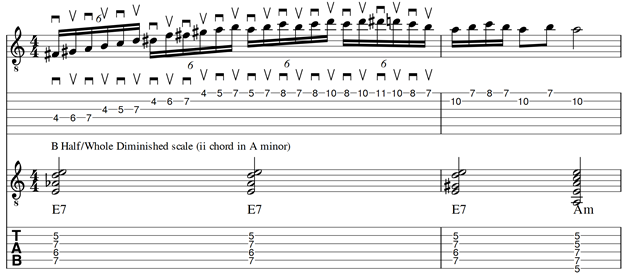Hi all, seeing if any theory people could help me out with this unusual scale application.
I was transcribing some spanish/latin style licks and came across this cool run:

Normally it would be a B Whole/Half diminished scale that would be played over the E7 chord but it this case it’s Half/Whole. I messed around improvising with both scales over E7 and to my ears the Half/Whole sounds so much better to me.
I tried looking on the interwebnets to see if there was any theory behind it but didn’t find anything. Best I could come up with why it sounded so good was that it might be a combination of:
- In a ii-V-i the B Half/Whole could be played over the Bm7b5 but here the ii chord is replaced with the E7 and the Half/Whole is played over the whole measure
- Even though there’s no E note in the B Half/Whole scale, over an E7 chord it has the 3, 5, b7, b9, 9, 11, and b13 tones. The rogue major 7 is a passing tone lending a little spicy D Phrygian sound.
In any case it’s a cool sound palette to play over a dominant chord when playing spanish style.
Thanks!



 . Also should of have know better because it’s maybe the most common dominant voicing for this style. From there it’s E7b9 = Bdim7/E = B half/whole diminished scale.
. Also should of have know better because it’s maybe the most common dominant voicing for this style. From there it’s E7b9 = Bdim7/E = B half/whole diminished scale.